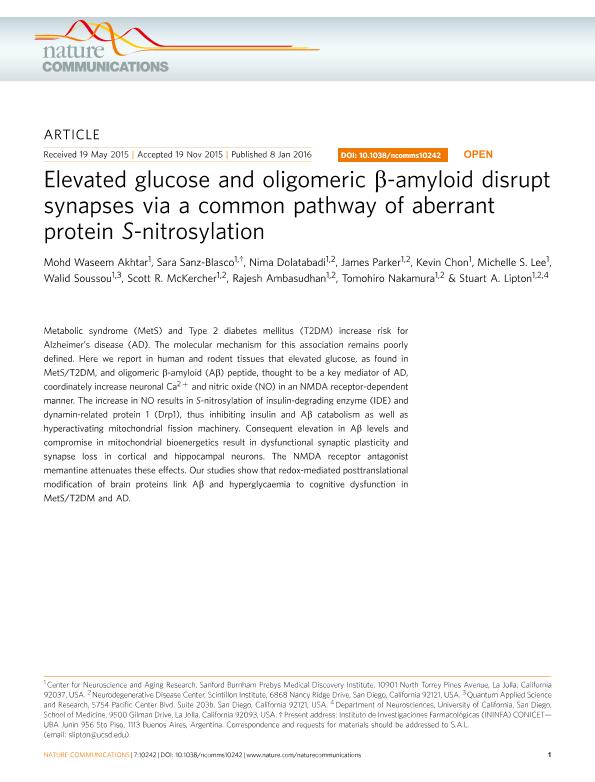Artículo
Elevated glucose and oligomeric β-amyloid disrupt synapses via a common pathway of aberrant protein S-nitrosylation
Akhtar, Mohd Waseem; Sanz Blasco, Sara Isabel ; Dolatabadi, Nima; Parker, James; Chon, Kevin; Lee, Michelle S.; Soussou, Walid; McKercher, Scott R.; Ambasudhan, Rajesh; Nakamura, Tomohiro; Lipton, Stuart A.
; Dolatabadi, Nima; Parker, James; Chon, Kevin; Lee, Michelle S.; Soussou, Walid; McKercher, Scott R.; Ambasudhan, Rajesh; Nakamura, Tomohiro; Lipton, Stuart A.
 ; Dolatabadi, Nima; Parker, James; Chon, Kevin; Lee, Michelle S.; Soussou, Walid; McKercher, Scott R.; Ambasudhan, Rajesh; Nakamura, Tomohiro; Lipton, Stuart A.
; Dolatabadi, Nima; Parker, James; Chon, Kevin; Lee, Michelle S.; Soussou, Walid; McKercher, Scott R.; Ambasudhan, Rajesh; Nakamura, Tomohiro; Lipton, Stuart A.
Fecha de publicación:
01/2016
Editorial:
Nature Publishing Group
Revista:
Nature Communications
ISSN:
2041-1723
Idioma:
Inglés
Tipo de recurso:
Artículo publicado
Clasificación temática:
Resumen
Metabolic syndrome (MetS) and Type 2 diabetes mellitus (T2DM) increase risk for Alzheimerâ €™ s disease (AD). The molecular mechanism for this association remains poorly defined. Here we report in human and rodent tissues that elevated glucose, as found in MetS/T2DM, and oligomeric β-amyloid (Aβ) peptide, thought to be a key mediator of AD, coordinately increase neuronal Ca 2+ and nitric oxide (NO) in an NMDA receptor-dependent manner. The increase in NO results in S-nitrosylation of insulin-degrading enzyme (IDE) and dynamin-related protein 1 (Drp1), thus inhibiting insulin and Aβ catabolism as well as hyperactivating mitochondrial fission machinery. Consequent elevation in Aβ levels and compromise in mitochondrial bioenergetics result in dysfunctional synaptic plasticity and synapse loss in cortical and hippocampal neurons. The NMDA receptor antagonist memantine attenuates these effects. Our studies show that redox-mediated posttranslational modification of brain proteins link Aβ and hyperglycaemia to cognitive dysfunction in MetS/T2DM and AD.
Palabras clave:
Alzheimer
,
No
,
Nmda
,
Β-Amyloid (Aβ) Peptide
,
Glucose
Archivos asociados
Licencia
Identificadores
Colecciones
Articulos(ININFA)
Articulos de INST.DE INVEST.FARMACOLOGICAS (I)
Articulos de INST.DE INVEST.FARMACOLOGICAS (I)
Citación
Akhtar, Mohd Waseem; Sanz Blasco, Sara Isabel; Dolatabadi, Nima; Parker, James; Chon, Kevin; et al.; Elevated glucose and oligomeric β-amyloid disrupt synapses via a common pathway of aberrant protein S-nitrosylation; Nature Publishing Group; Nature Communications; 7; 1024; 1-2016; 1-11
Compartir
Altmétricas



